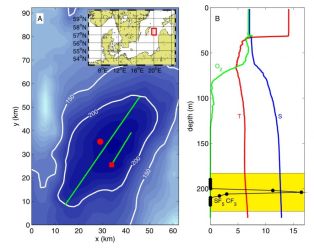
Project details: BaTRE
| Acronym: | BaTRE |
|---|---|
| Title: | Baltic Sea Tracer Release Experiment |
| Duration: | 01.01.2007 - 31.12.2010 |
| Project manager: | PD Dr. Lars Umlauf |
| Funding: | DFG |
| Focus: | Transport and transformation processes |
| Department: | Physical Oceanography and Instrumentation |
| Participation: | Toste Tanhua (IFM-GEOMAR, Kiel, Germany) |
| Co-operation: | Jim Ledwel, WHOI, Woods Hole, USA |
Staff
Dr. Peter Holtermann, Tel.: +49 (381) 5197-173
Description

One of the outstanding questions for the Baltic Sea ecosystem is how physical and bio-geochemical properties of the deep layers communicate with the surface mixed layer where production takes place. In a joint project of IOW and IFM-GEOMAR (Kiel) these mixing process are currently investigated in the framework of the Baltic Sea Tracer Release Experiment (BaTRE), conducted in 2007-2010.
In collaboration with the tracer research group of Jim Ledwell (WHOI), a new type of tracer, SF5CF3, was injected in September 2007 into the deep waters of the Eastern Gotland Basin with the help of the new Oceanic Tracer Injection System (OTIS) built for this project (see Umlauf et al. 2008). The figure to the right shows the study area, the vertical distribution of the tracer (markers in highlighted area), and some hydrographic parameters as measured approximately two weeks after the injection.
The experiment is accompagnied by extensive turbulence measurments in order to obtain direct mixing estimates for comparision with the basin-scale mixing inferred from the vertical spreading of the tracer cloud. Combined with additional moored instrumentation (ADCPs, current meters, CTD loggers), a coherent data set is available for the identification of processes responsible for the overall mixing.
In addition to the field program a numerical study of the tracer experiment was conducted using the General Estuarine Transport Model (GETM). This study aimed to fill the gaps between the measurement campaigns, especially during the first months after the tracer release, since this period was undersampled in time. The model was used to perform an ensemble tracer release showing the importance of the injection location for the tracer evolution.
Results
One of the major results of the experiment was the significant difference between the interior mixing rates and the basin scale effective mixing rates. These differences point to the importance of boundary mixing processes in the Gotland Basin. A detailed discussion of the mixing rates derived from the tracer release can be found in Holtermann et al. 2012.
Based on the long-term moorings three deep-water motions have been identified: A rim-current, topographic waves with periods of approximately three days and internal waves with periods of 14 hours and less. The shear-microstructure data depicted the importance of mixing processes just above the well mixed bottom-boundary layer, refer also to Holtermann & Umlauf 2012.
The, in time, undersampled period shortly after the tracer injection made it difficult to interprete the first tracer profiles. This is due to the starting interaction of the tracer patch with the boundary mixing processes. To understand this transition from solely interior mixing to a combination of interior and boundary mixing processes an eddy resolving numerical model of the Central Baltic Sea was set up and carefully calibrated with the existing BaTRE dataset. Using vertically adaptive coordinates it could be shown that the model could reproduce the difference between interior and boundary mixing processes and thus the evolution of the tracer patch (Holtermann et al. 2014). As example of the model results the interaction of the tracer patch with the boundary is shown in the video below.
Video of the tracer evolution
Model result of the tracer concentration for the first three months after the release.
Publications
- 2014
- Holtermann, P., H. Burchard, U. Gräwe, K. Klingbeil and L. Umlauf. Deep-water dynamics and boundary mixing in a nontidal stratified basin: A modeling study of the Baltic Sea. J. Geophys. Res. Oceans, 119, doi:10.1002/2013JC009483, 2014.
- 2012
- Holtermann, P., L. Umlauf, T. Tanhua, O. Schmale, G. Rehder, and J. Waniek. The Baltic Sea Tracer Release Experiment. Part I: Mixing rates. J. Geophys. Res., 117, C01021, doi:10.1029/2011JC007439, 2012.
-
- Holtermann, P., and L. Umlauf. The Baltic Sea Tracer Release Experiment. Part II: Mixing processes. J. Geophys. Res., 117, C01022, doi:10.1029/2011JC007445, 2012.
- 2008
- Umlauf, L., T. Tanhua, J. J. Waniek, O. Schmale, P. Holtermann and G. Rehder (2008). Hunting a new oceanic tracer. EOS 89(43): 419-420